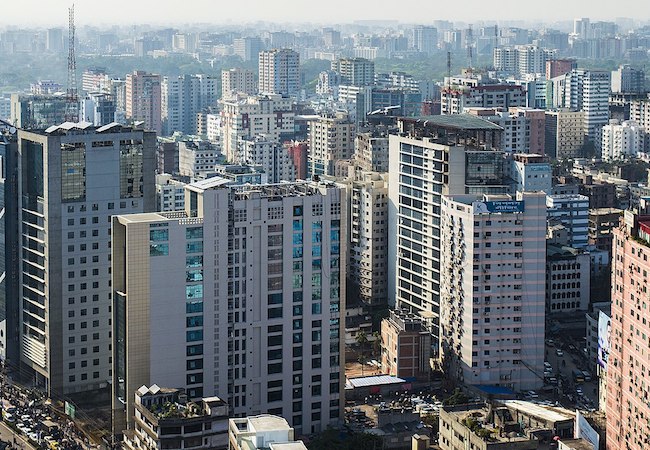Punching above one’s weight: Is Bangladesh slated to be the New Asian Tiger?

By Samarth Kavoori
The World Bank (WB) released reports indicating that the GDP growth rate for Bangladesh in the 2019-20 fiscal year is expected to be 8.1 percent. Contemporaneously, the United Nations Conference on Trade and Development (UNCTAD) affirmed that India’s GDP growth rate barely scraped the 6 percent mark, a seven-year low. Furthermore, Standard Chartered reported Bangladeshi’s will be economically better off than Indians by 2030 with a per capita income of USD 5,735 compared to USD 5,423 for India. What’s more, Bangladesh’s income inequality is considerably lower at present with a Gini coefficient of 32.4 in contrast to India’s 35.1. What contributed to these statistics?
Critics argue that the recently re-elected NDA-led government has neglected India’s decades-long aspirations of economic evolution to predominantly focus on geopolitical dimensions in South Asia. However, economists cite issues such as the much-criticized banknote demonetization that took place in 2016, the fall in consumer demands and to a lesser extent the slowdown of the real-estate sector. In the Bangladeshi scenario, the primary political factor in favor of the booming economy that analysts identify is the stability of Sheikh Hasina’s Awami League government with its visionary economic ambitions. While India chose to partially abandon the industrialization model i.e. manufacturing-centric and an export-driven growth model for a more service oriented one, Bangladesh, in contrast, pursued the Chinese and East Asian models.
As the second-largest garment exporter in the world after China, the industry employees nearly 5 million workers and the apparel sector contributes roughly 20 percent to the country’s GDP. Added to this, Bangladesh has availed the zero-tariff preferences offered by markets in the developed world, that has boosted the sector considerably. Furthermore, reports suggest that Bangladesh has almost achieved self-sufficiency in food production as of 2019. Nevertheless, self-sufficiency in production isn’t the only parameter to measure nutritional benefits for a large population, one must account for the distribution systems as well. Take the case of India, in the financial year 2018-19, a record of 283.37 million tons worth food-grain production was registered, however, the country ranked 103 in the Global Hunger Index, well below its South Asian neighbors. Thus, there are multiple components involved in this article to determine the probable Bangladeshi view of the Indian and East Asian models of Economic prosperity?
The Indian model isn’t singular in nature and the philosophy behind the present market system has varied since the 1992 liberalization. However, the incumbent government’s refusal to accept the economic slowdown has led to speculations indicating worsening conditions that may eventually prove to be a nightmare for India. Moreover, the Bangladeshi government is prudent enough to foresee this aspect and thus owing to India’s slump, the country looks east to the Asian models. In return, Bangladesh’s emphasis on manufacturing hits India hard, as it slowly realizes the haphazard steps taken by the incumbent and previous administrations of moving to a service-based economy instead of accepting the steady manufacturing industry-based approach whose prominence has persisted since China’s success.
While approaching the Chinese model, a question that comes into mind is the shift from a manufacturing-driven economy to a service-based one. How is Bangladesh going to confront this transition? A major question for its incumbent government and policymakers to shape the socio-economic dynamics of the state. One way out that economists claim is increasing private investment and divestment of state-owned enterprises. Besides, this is likely to lead to an increase in job opportunities and a gradual move in the direction of a service-based economy. Currently, Bangladesh is in the process of developing its Information Technology industry, privatization is expected to help this industry becoming more sophisticated and matching global standards. Bangladesh is also developing several projects with China in the Belt and Road Initiative (BRI) in order to increase its global footprint, this includes the development of Special Economic Zones (SEZs), Export Processing Zones (EPZs), major infrastructure projects, etc. Moreover, owing to its involvement in the BRI, Bangladesh is likely to attract American interests amidst its trade war with China.
Although Bangladesh shows a promising future as an important actor in the Global Geo-economic front, it needs to address major social and economic issues at home. For e.g. the Ease of Doing Business-rankings, where Bangladesh has fared the worst in South Asia, although Bangladesh Investment Development Authority (BIDA) is in the process of addressing the issue. Other indicators such as an under-developed power sector, weak infrastructure and high employment vulnerability are also issues that need considerable attention.
With less than two years remaining for Bangladesh’s Vision 2021 that declares its aspiration to become a lower-middle-income country looks well in sight barring a few aspects. However, work remains for its aim for Vision 2041 where it expects to achieve the status of a developed country.
Samarth Kavoori has graduated with an MA in Diplomacy, Law and Business from O.P. Jindal Global University and works as an analyst at a security risk management company called Grid 91 in Mumbai with emphasis on Geo-economics in South Asia.







